40+ Different Types Of Jade Plants (Crassula Ovata) With Pictures
Jade plants are known as succulents and are one of the most popular houseplants not only because of the beauty they add to a home but because most people believe that it gives fortune and luck. Aside from this, it really is low-maintenance. It just needs occasional watering and a bit of sunlight to thrive.
If you are looking for something that would naturally enliven your room, jade plants would do. The good news is that there are different types of jade plants out there. In this post, we shall look into these for you to have a view of what your choice could be.
In this article:
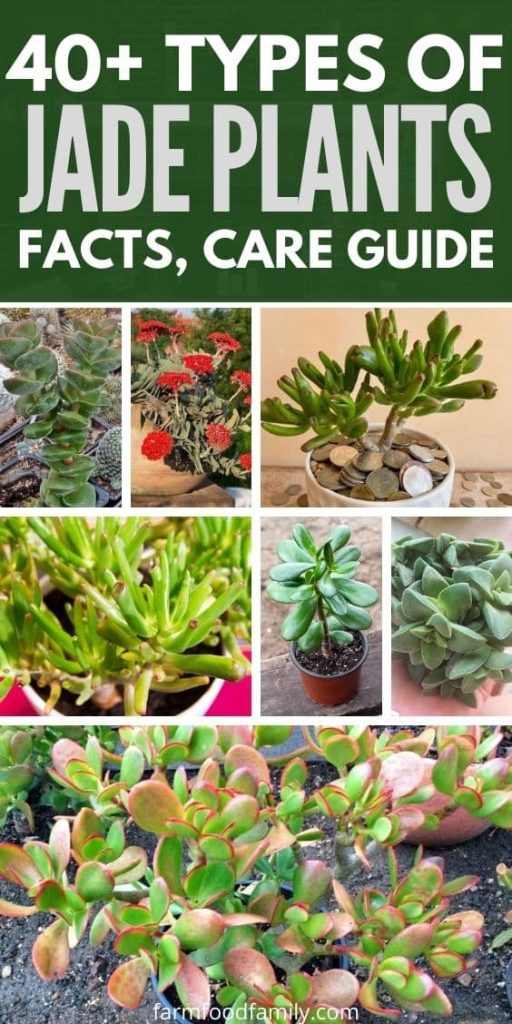
How many types of jade plants are there?
A plant considered to be natives of South Africa, jade plants have at least 200 different species available across the world. This plant primarily gets its name from its jade green color and leaves that are either tear, oval, wedge in shape.
Jade plant symbolism
The most popular symbolism for the jade plant is its representation of good fortune. Jade plants or called as the lucky plant are considered as the best gift to a friend who is moving into a new home or to a newlywed as it is believed that it symbolizes prosperity and friendship.
Jade plants are very central in Chinese culture. As such, it is a popular gift given or used as decoration during special occasions like weddings, housewarming parties and even on birthday parties.
They are also given as souvenir gifts to visitors. Although it is a bit pricey, these symbols suffice for the price and its ornamental value is superb.
Jade plant identification
So, how do you identify a jade plant from afar? Since it is always associated with succulents, it would be best to know how to tell them apart.
Stem
Its miniature tree-like appearance is due to its thick and woody stems. They reach a thickness of at least 4-inches, and are very fleshy like succulents.
Leaves
Its leaves, as have been mentioned, have a unique tear-shaped look. They can be glossy or waxy, can grow to a length of 3-inches, and may also come in ovate or wedge look.
Flowers
Under the right conditions, jade plants could also flower. This happens most specifically when the weather is dry, like in summers or winters. Depending on the climate and the sunlight it gets, jade plants can produce pinkish-white and star shaped flowers.
Types of jade plants
Given what we have already covered, the hype thrown over jade plants is lived up with. In this section, we shall look at some of the most popular types of jade plants out there.
1. Crassula Arborescens (Silver Jade Plant)
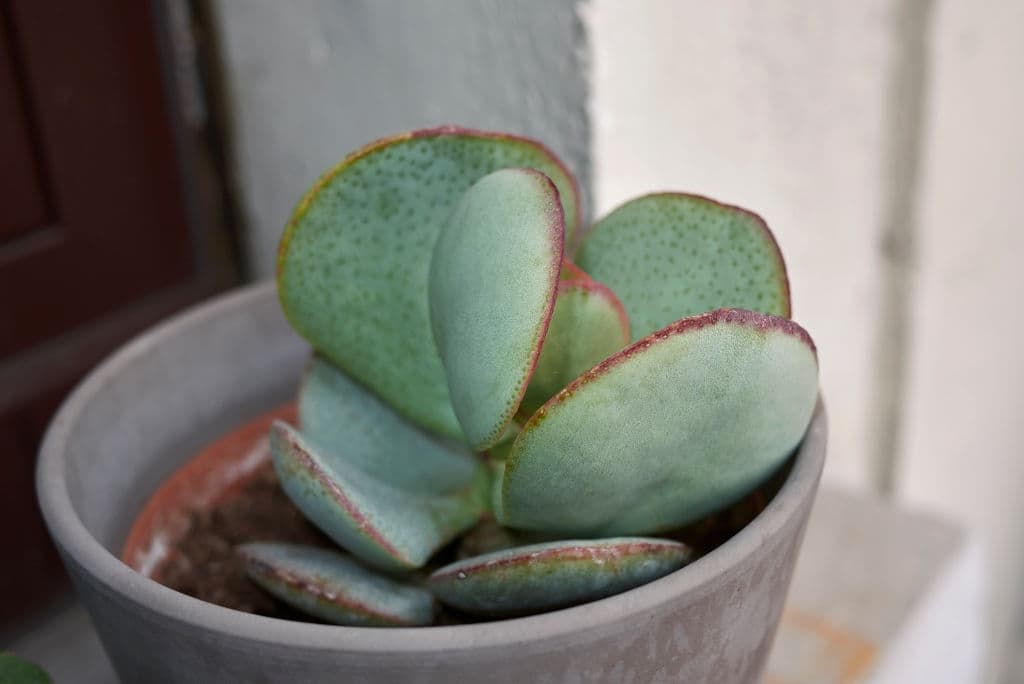
This type of jade plant is also known as the jade plant, silver dollar plant or money plant. This type of jade plant is believed to bring luck in a home.
It is best identified for its grayish-silver leaves that have a dollar shape. This type of jade plant lives well outdoors but can also live indoors.
Related: Money Tree Plant: How To Grow and Care For Pachira Aquatica
2. Crassula Arborescens Blue Bird Variegata
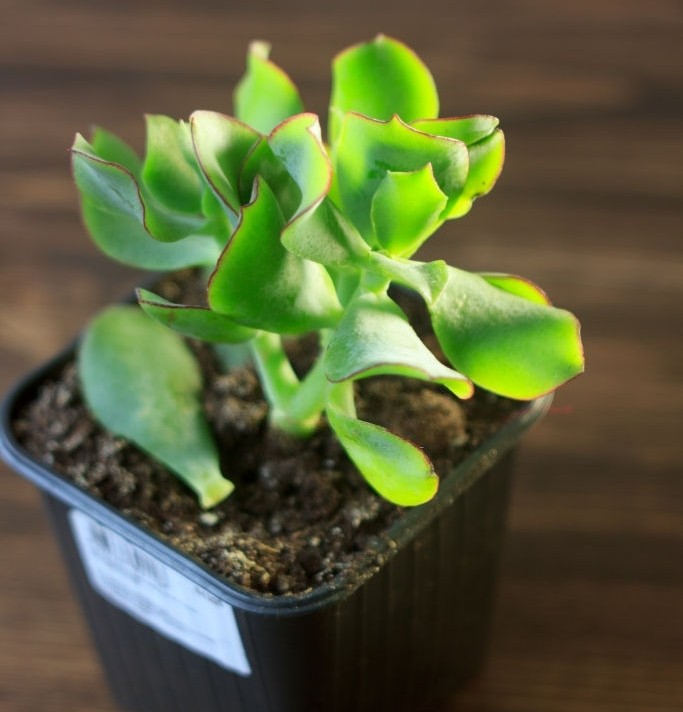
This type of jade plant is commonly known as Blue Bird money plant or Jade Plant. It grows slower than the other types.
Its identification is that its leaf’s color is a mixture of aqua blue, cream, green and red. It grows very small so it is perfect as a container plant.
3. Crassula Arborescens Undulatifolia (Ripple Jade)
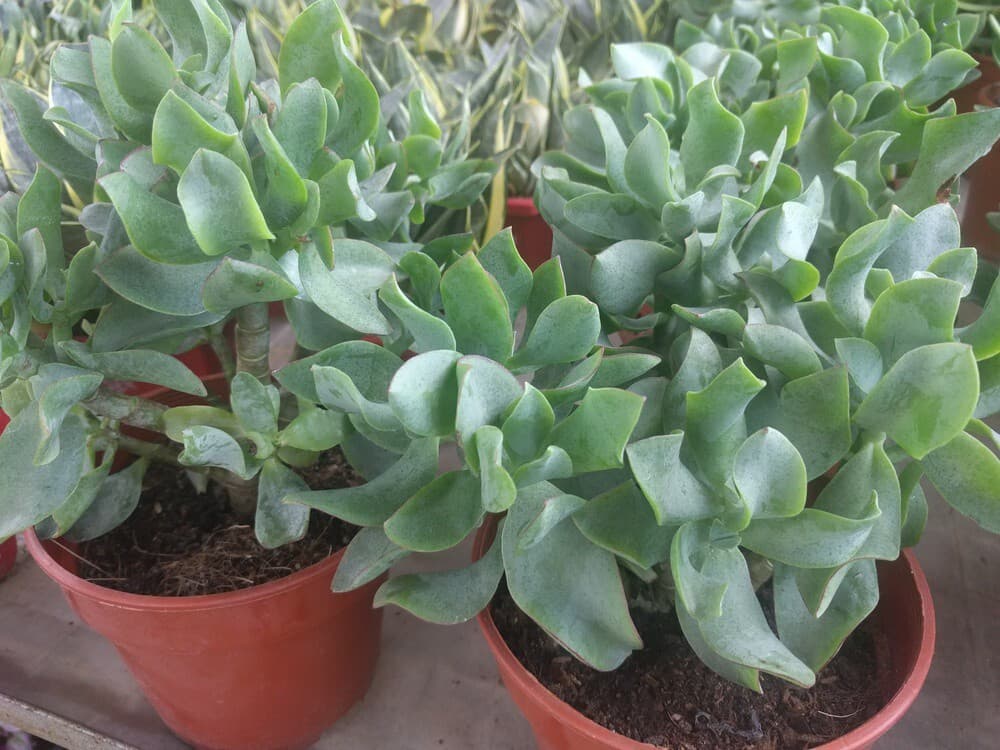
This type of jade plant is most commonly known as the Ripple Jade. It only grows at about 3-ft and is considered as a slow-growing jade plant. It is also compared to a bonsai plant for its size although that is really its natural height.
4. Crassula Capitella Campfire
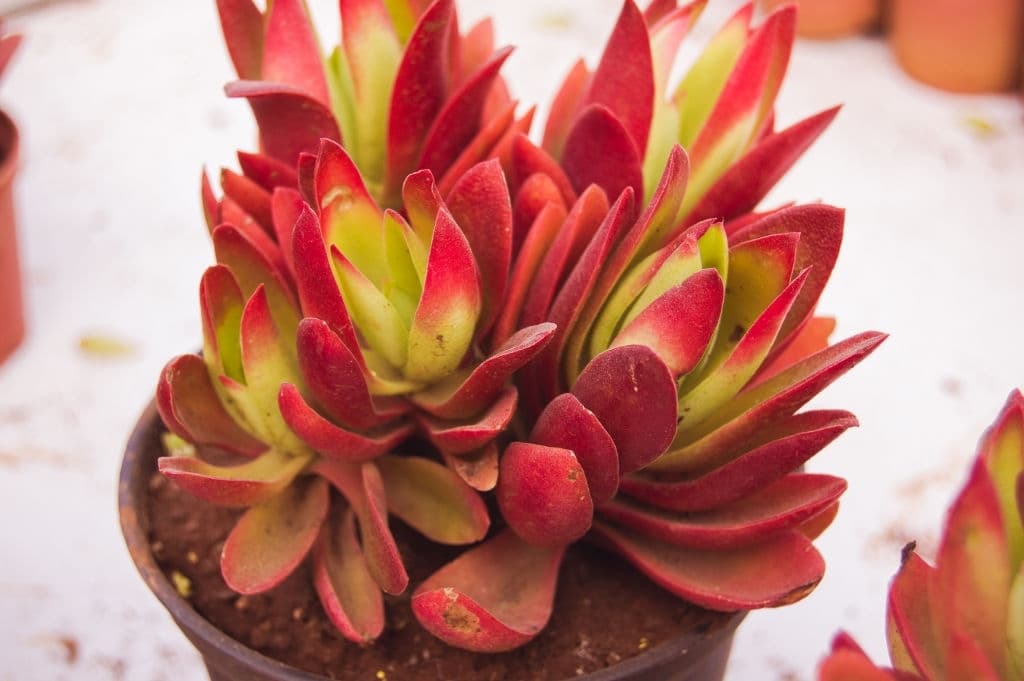
This type of jade plant is best known for its foliage that looks like an airplane propeller. It comes with either a bright red color or the usual light green tone. In the summer, it blooms white, tiny flowers.
5. Crassula Coccinea (Red Jade Plant)
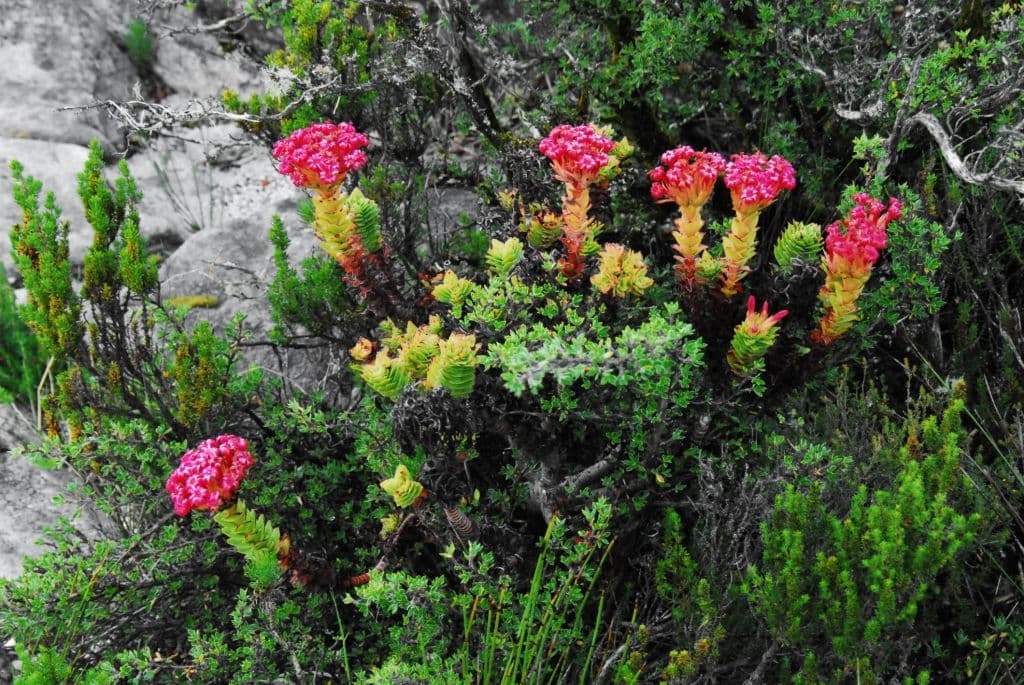
This type of jade plant is also called the Red Jade, making it a standout from the other jade plant species because of its deep red color.
It is also easily identified with its triangular leaves which are almost conal in form. It also blooms white flowers during summer.
6. Crassula Cultrata (Blush Plakkie)
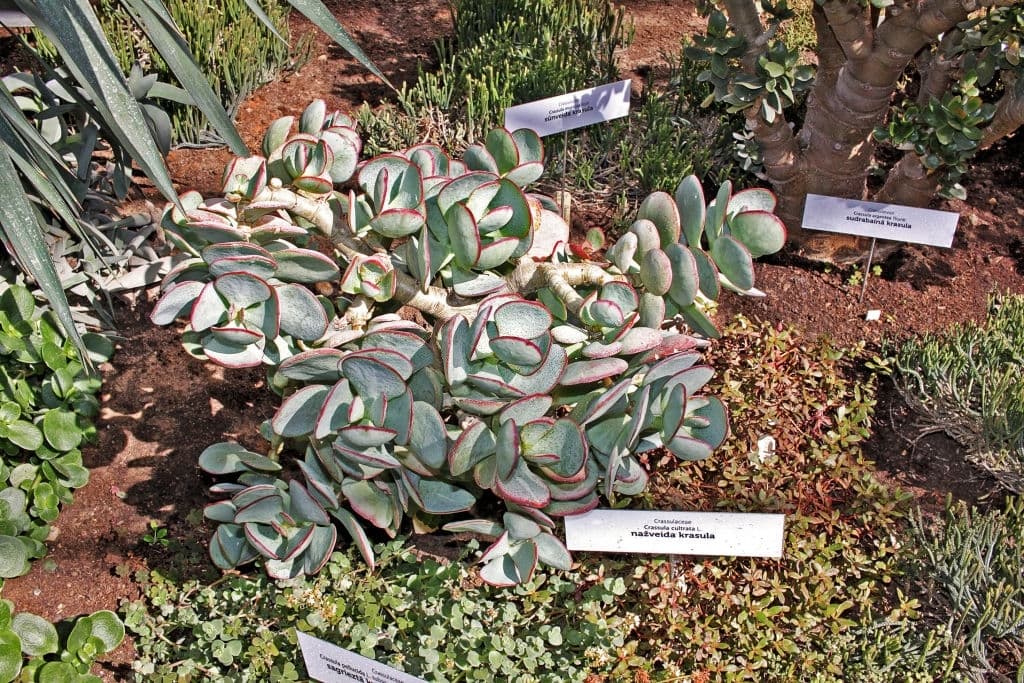
This type of Jade plant is also named as the ‘Sharp-leaved Crassula.’ It is easily identified as its stems are color red and its leaves are light green, elongated and tear-shaped.
It also has a shade of reddish brown that can be seen towards the edge of this plant. The flowers it produces are yellow in color.
7. Crassula exilis ssp. picturata (Tiger Jade)

This type of Jade plant is also called the Tiger jade. It is a small sized jade plant with green leaves with white speckles, hence the name. Tiger jade is advisable to be placed indoors since it does not require a lot of sunlight.
It only needs good drainage and occasional watering. This type of Jade plant grows in high temperature areas or hot regions where water source is poor. It produces flowers that are pale pink in color.
8. Crassula Falcata
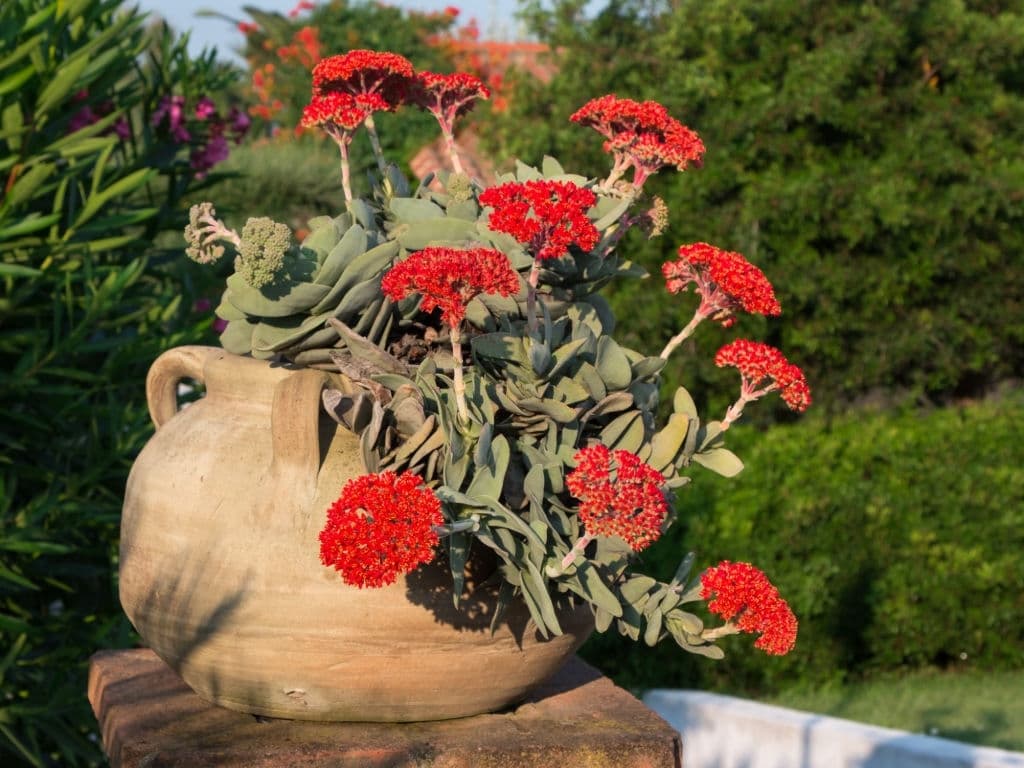
This type of jade plant is considered as a propeller plant because of its easy cultivation. Its foliage is standout since it is twisted in opposite pairs creating a propeller look. Its main identification is that it has gray-green in color and its seemingly overlapping leaves.
This type of jade plant does not always produce flowers but when it does, red flowers emerge in the center of the propellers. Unlike other types, this type requires bright light to develop beautifully. It prefers normal room temperature making it best indoors.
9. Crassula Jade Tower
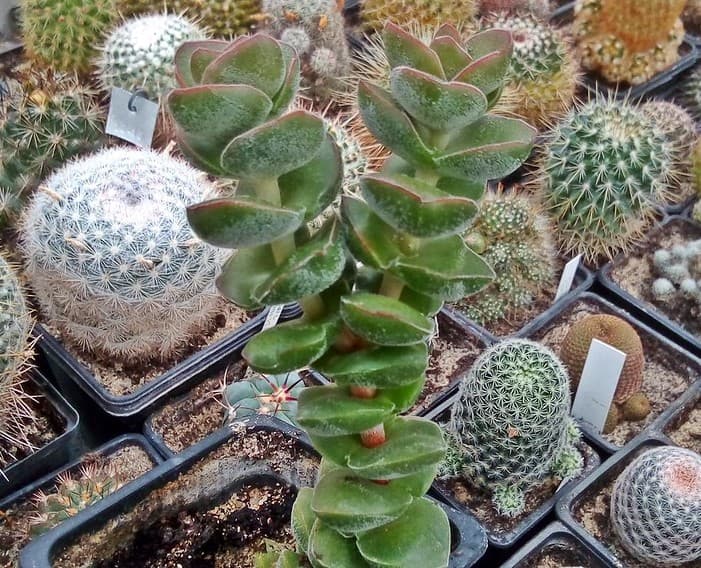
This type of Jade plant can be easily identified with its erect leaves, forming columns which are green in color, look frosted and have a white papilla. It blooms small, pinking flowers which are extremely beautiful during its blooming season.
10. Crassula Marnieriana (Jade Necklace)
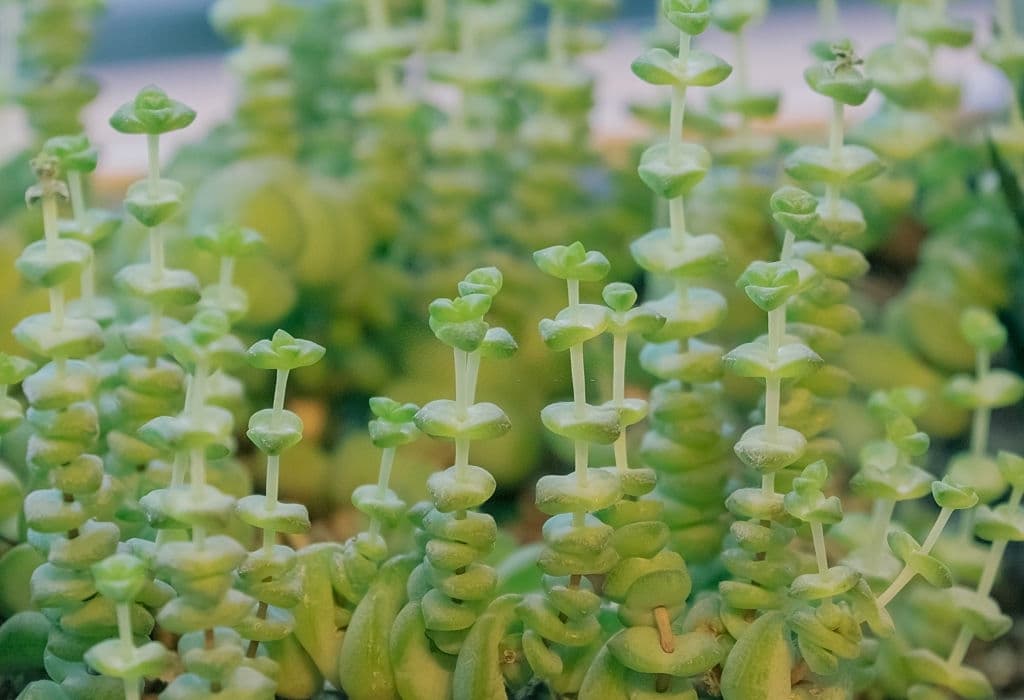
Just like silver springtime jade, this also has thin leaves covered in a triangular leaf. As its name suggests, this jade plant has a necklace-like appearance and flowers bloom in the color white from the end of its stems during winter.
11. Crassula Ovata (Money Plant)
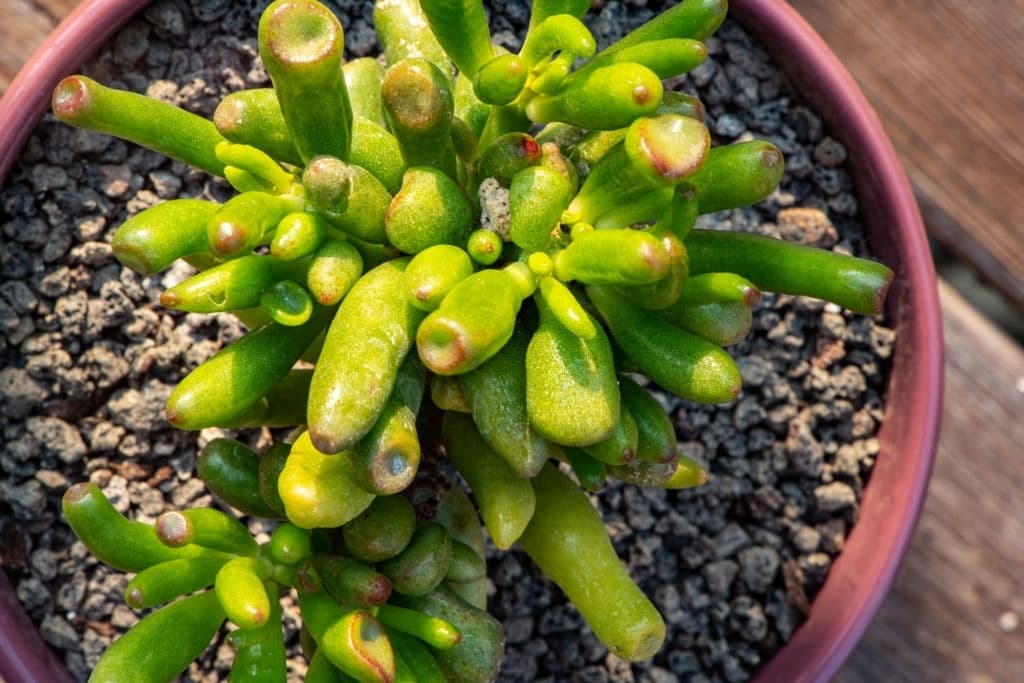
This type of jade plant is the most popular jade plant. People call it a money plant or money tree as its feature brings out its tree-like aura. It is identified by its jade-green, tear-shaped leaves and has white, star-shaped flowers emerging during winter.
It is considered as an indoor plant and is best placed in a bright location away from direct sunlight. This type of Jade plant is believed in feng shui to bring good luck so it should be placed in the money area of a home or an office.
12. Crassula Ovata Botany Bay (Lucky Jade)

This type of Jade plant is popularly identified because it has leaves that are coin-shaped, hence, also a bringer of money and fortune.
It is considered as a slow-grower, and more of a shrub than a plant. One unique quality of this type is that it has light jade-green foliage with red margins.
13. Crassula Ovata Crosby Compact (Dwarf Jade Plant)
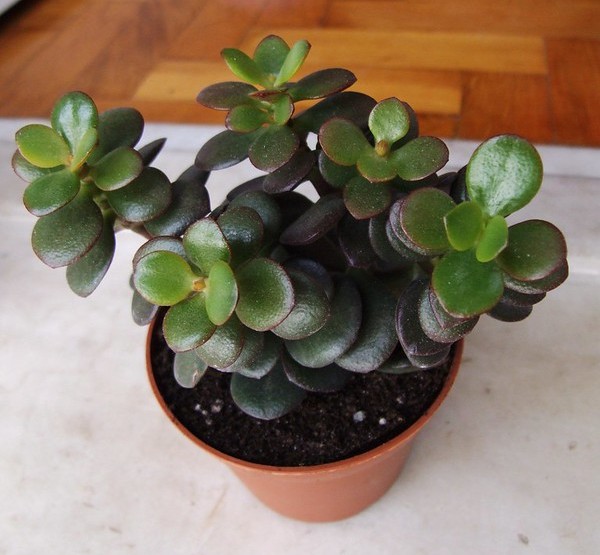
This one has light green branches and tear-shaped leaves. It is one of the smallest if not the smallest jade plant since it only grows to a maximum of 2.5-cm.
Nonetheless, it is still loved for its ornamental value. All of its new leaves tend to be red in color.
14. Crassula Ovata Gollum (Gollum Jade)
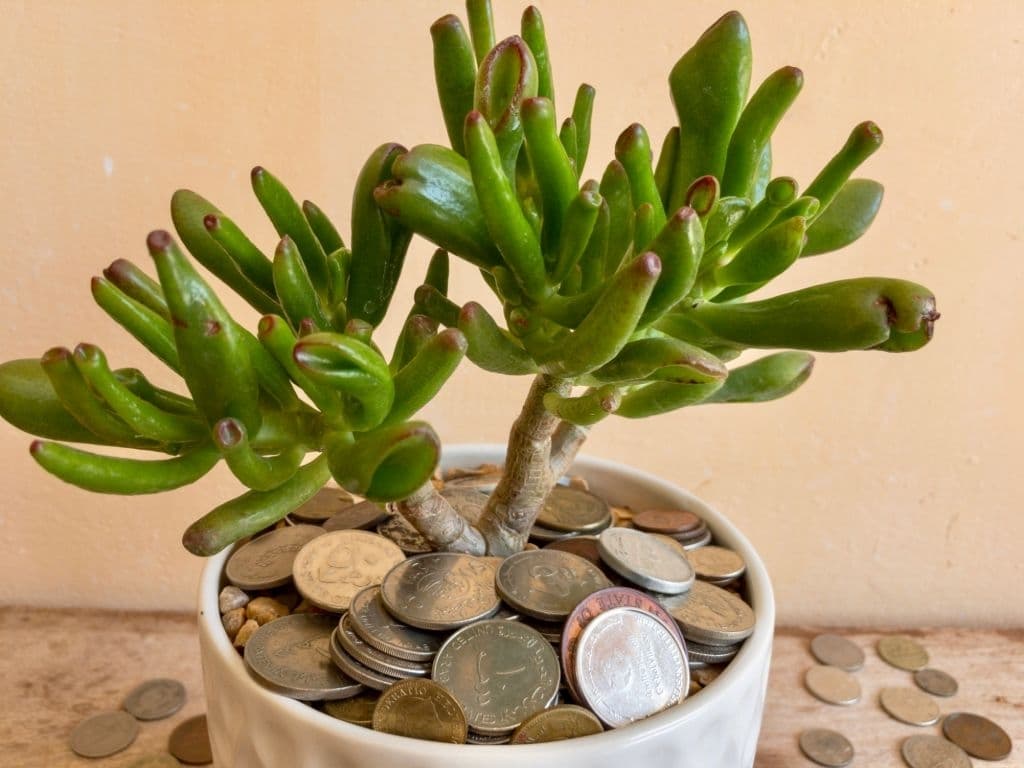
This type of jade plant is also called the ‘Finger jade,’ ‘Hobbit’s pipe jade,’ and ‘Trumpet jade.’ Its main identification is that it has brown branches which contain bunches of succulent leaves that grow near their top.
One of its varieties is the Trumpet Jade which are brightly- colored that are yellow and green in color with a shade of red. If you are a bonsai fan, this is the most suitable type for you to create a jade bonsai tree.
15. Crassula ovata Gollum Variegata (Variegated Gollum Jade)
This one has the most beautiful combined colors: green, white, pink and more. This plant is advisable in a seaside garden and will generally thrive during winter and autumn. One interesting fact about this type is that the color foliage changes under the cold.
16. Crassula Ovata ‘Harbour Lights’ (Harbour Lights Jade)
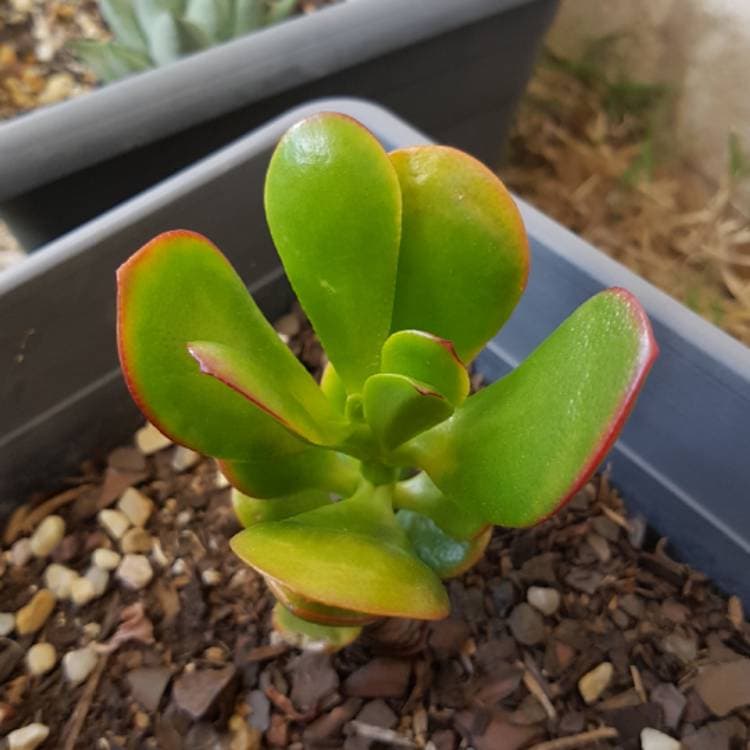
This type of jade plant is almost always interchanged with the botany bay jade plant because of their similarity in terms of the stem, the leaves, and their color.
Perhaps, the only stark difference they have would be the distinct, starry pink color of its star-shaped flowers.
17. Crassula Ovata Hobbit (Hobbit Jade)
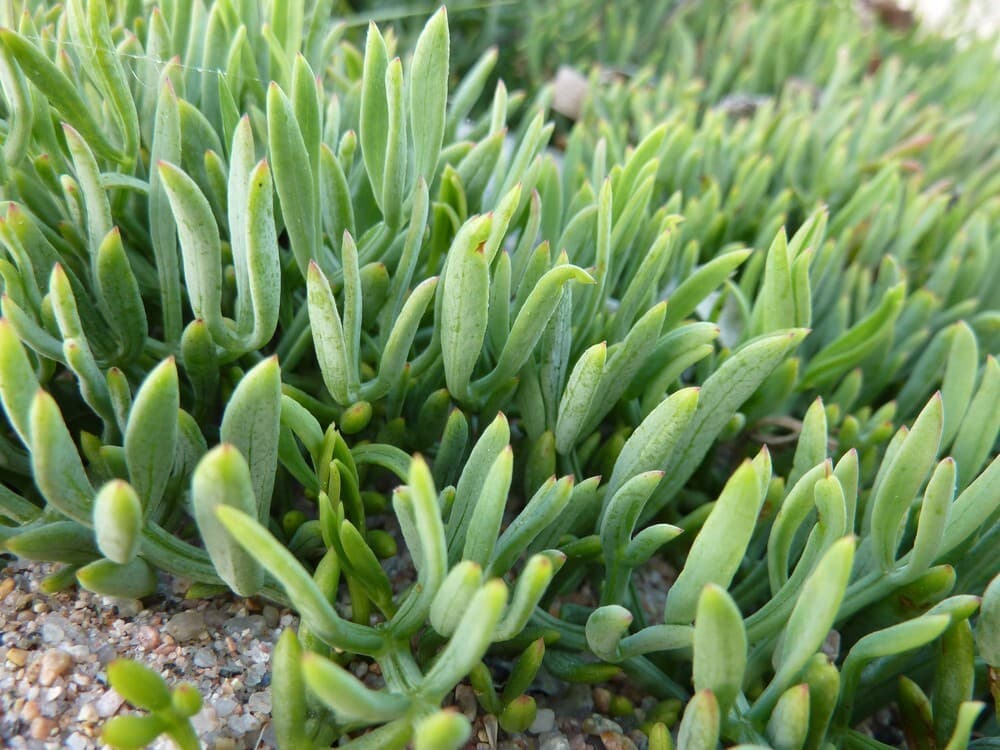
This type of jade plant is also known as Hobbit Jade and considered as a lucky tree. It is one of the best plants to transform into bonsais.
The many interesting features of this jade plant include its green leaves with red edges and an overall tubular shape. It is said that the amount of trimming you do with this plant connotes the amount of fortune and happiness it brings.
18. Crassula Ovata Hummel’s Sunset (Golden Jade Tree)
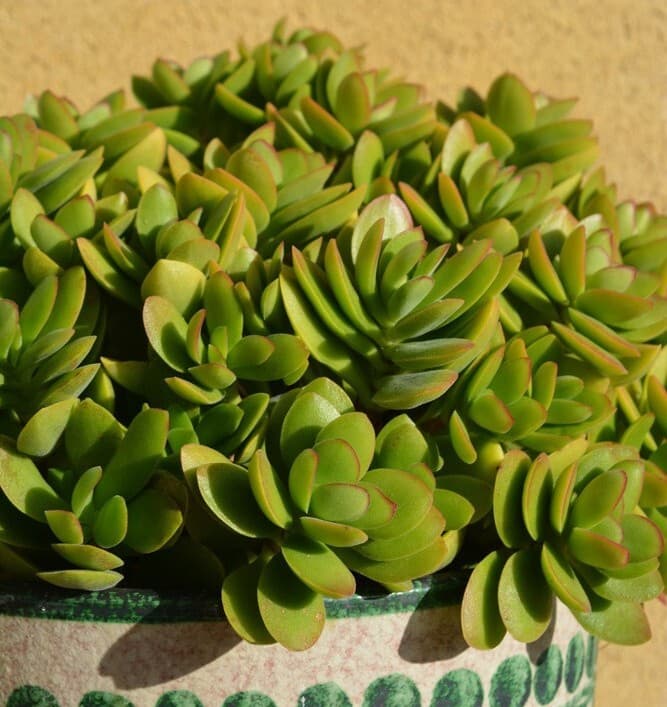
This one is an award-winning beautiful plant that has golden yellow and green leaves. Its main identification is that it has thick woody stems and branches, and has tear-shaped leaves that are lime green and yellow in color with a touch of red on its edges.
These colors pop out strongly especially during the cold months. In summer, or during higher temperature seasons, the color of its leaves changes into a mustard color.
19. Crassula Ovata ‘Lemon & Lime’ (Variegated Jade)
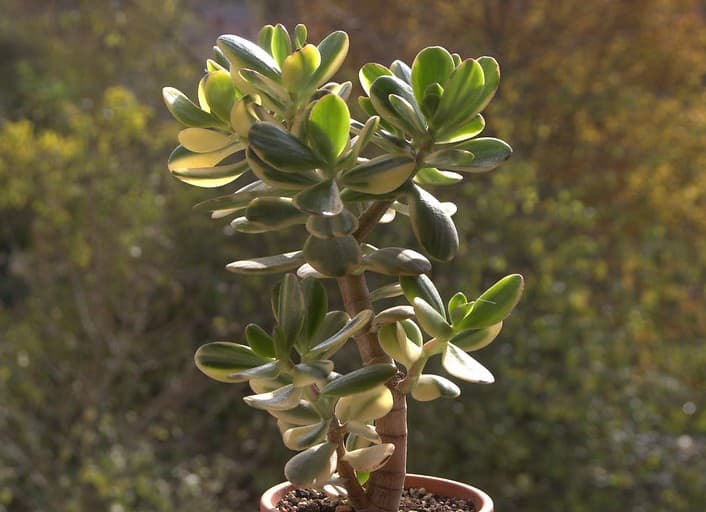
The main identification of this jade plant is its elongated oval leaves with lime green and yellow stripes.
These leaves grow up to 5cm long, forming red edges when it receives a lot of light. It can grow to up to 4ft and can be pruned and maintained as a shrub.
20. Crassula Ovata Little Jade Tree
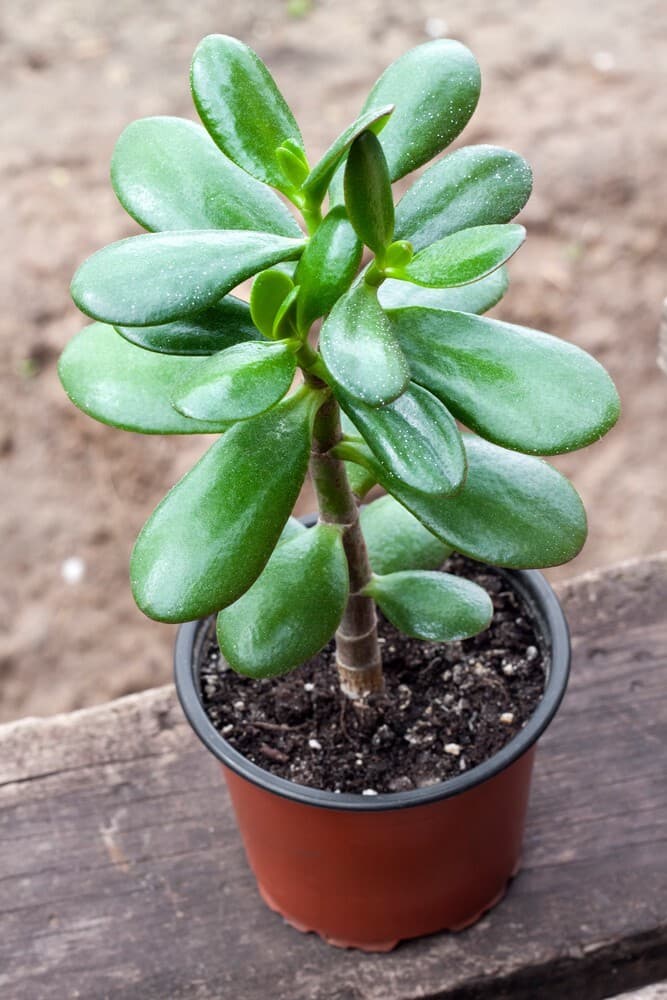
This type of jade plant is commonly known as the Little Jade tree. It is a very recent hybrid as it has only been around since 2015 in the Glenfield Wholesale Nursery.
It is one of the most popular jade plants used as souvenirs or as indoor plants, placed in small dish gardens.
21. Crassula Ovata Minima (Miniature Jade Plant)
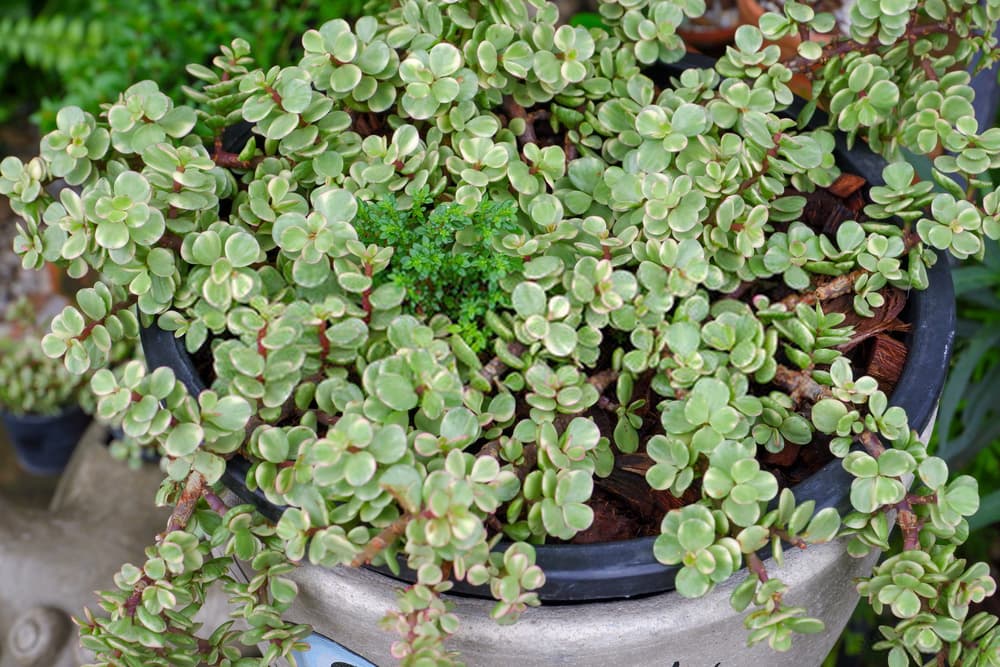
This is another one of the dwarf species of jade plants. It stops growing at 3ft. Its main identification is that it has small green and red pointed leaves.
Unlike other types of jade plants, its foliage is not compacted which makes it have a more tree-like appearance. This type of jade plant does not guarantee luck when having one but will make your house or room look more sophisticated.
22. Crassula Ovata Pink Beauty (Pink Jade)

This type of Jade plant is also called the ‘Pink Beauty’ because it has more pink colors in it than the jade green colors. Even its stems are pink in color so it can be easily identified.
This is one of the tall types which can grow up to 1.5 meters tall. It has flowers which are star-shaped and still in color pink. It also has a nice scent that will brighten up your mood especially during winter.
23. Crassula Ovata Pixie
This type of jade plant is best as a houseplant. Its foliage develops a red leaf margin during dry conditions. It grows excellently in a pot. The flowers it produces are small white and pink in color which appears above its foliage.
The height is determined by the size of the pot used in this type of jade plant. It requires bright lights and thorough watering.
24. Crassula Ovata Ripple Jade
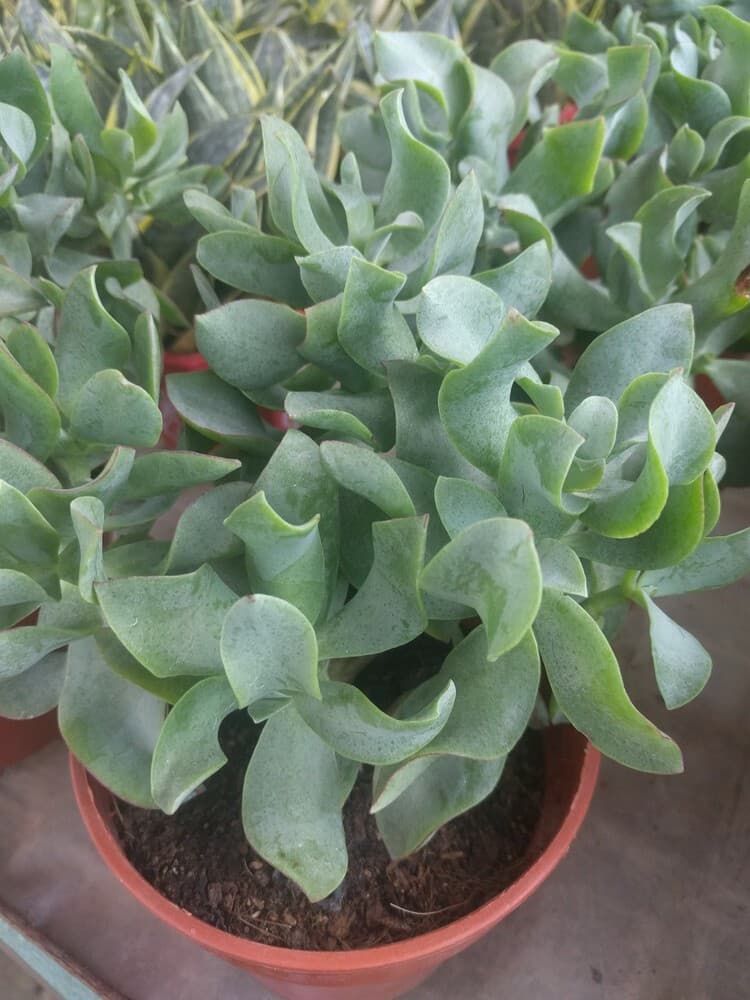
This type of Jade Plant is also called as Curly Jade because of its circular, twisted leaves which are mainly green with a touch of faded blue color.
Each of the leaves has a purplish to dark brown color effect on the edges although the main foliage is always green. It is very drought tolerant and will grow better when regularly pruned.
25. Crassula Ovata Ruby
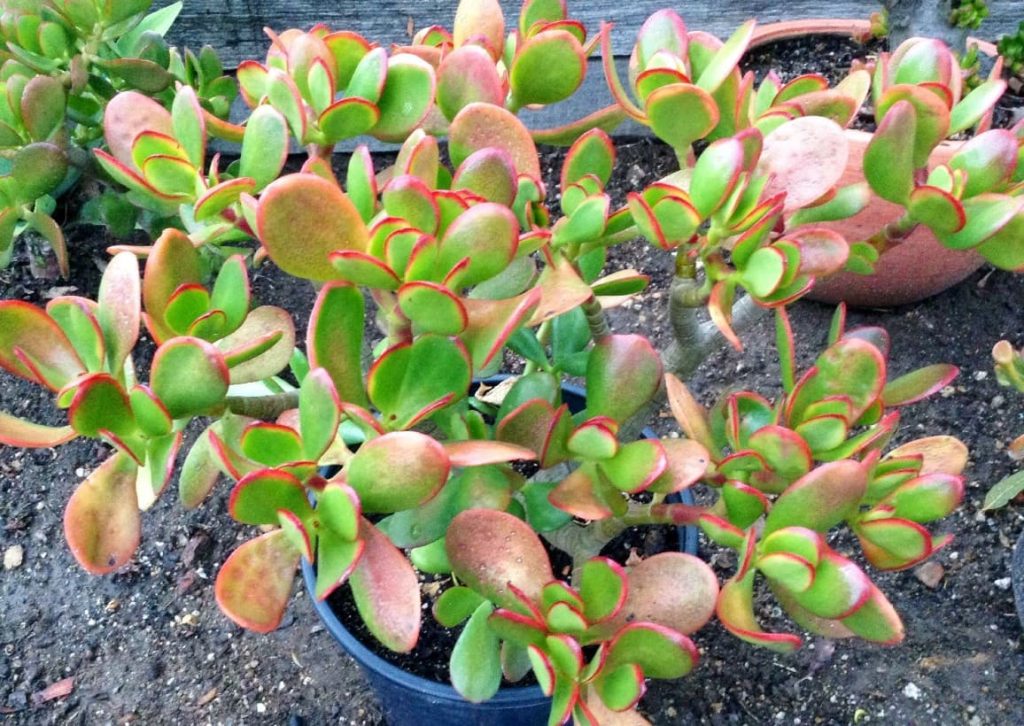
This type of jade plant can be identified with its unique ruby and blushy red colored leaves.
It also sports small, white and pink flowers and grows at just a meter for five straight years. It is best for coastal gardens and it also requires regular trimming for it to maintain its shape.
26. Crassula Ovata Sienna
This type of jade plant can be identified mainly for the flowers it produces. It has small, white and pink colored flowers which appear above the foliage. The height of this type depends on the container size and trimming.
Ideal for a houseplant and best placed in table tops, window sills and other more places. It is also considered to be a fine souvenir gift since it can thrive in small pots.
27. Crassula Ovata ‘Skinny Fingers‘
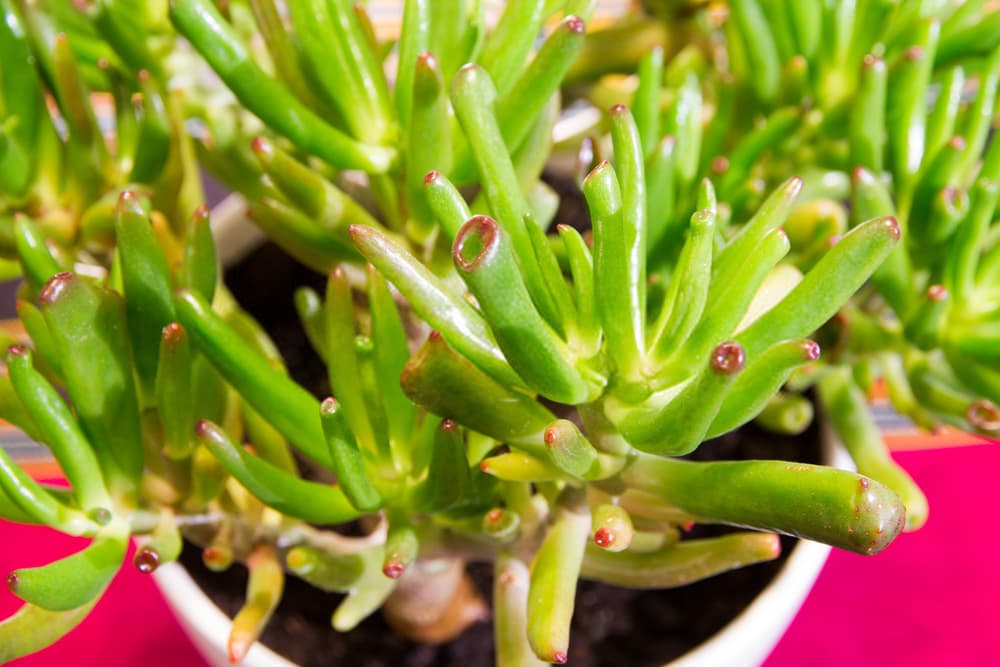
This type of jade plant is identified for its succulent leaves that look like thin fingers. It is jade in color that can grow up to 5cm and features reddish tips. It is a smaller type of jade plant.
If you are lucky, the flowers that emerge are small star-shaped and white and pink in color. This type of Jade plant is likened to that of the Jade Gollum and Jade hobbit plants.
28. Crassula Ovata Undulata (Wave Jade)
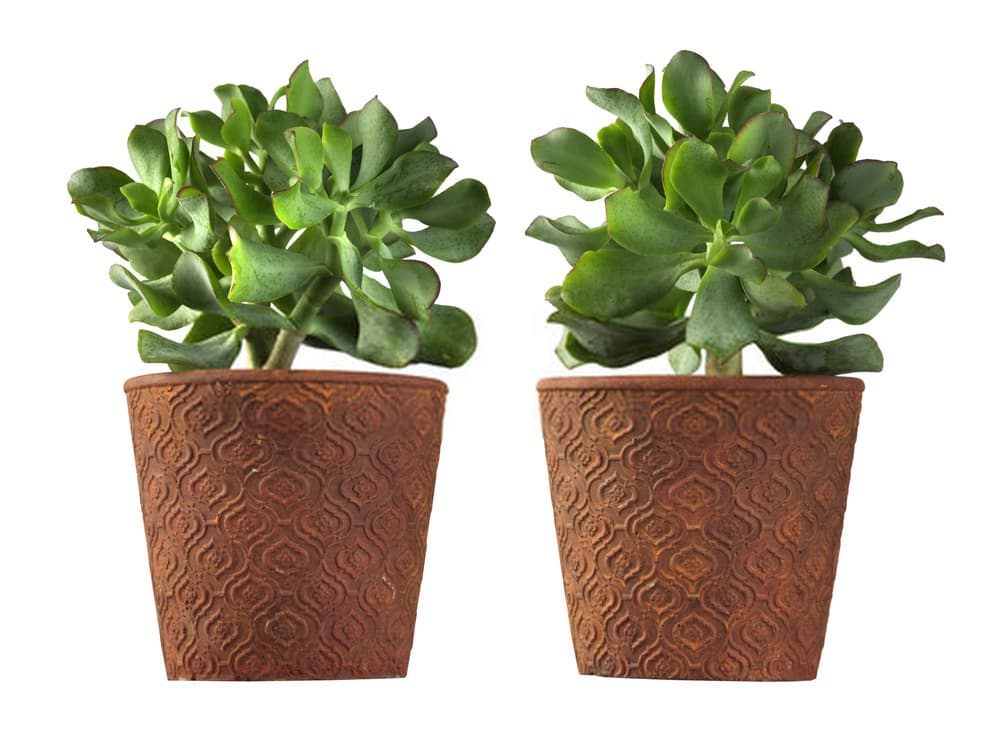
This type of Jade plant is also called Wave Jade. From its name, it has wavy, blue-green leaves with red margins (which best come out when placed in cooler temperatures).
29. Crassula ovata Undulata
This type of Jade plant has bright green leaves with fine red margins. This one is almost never pruned. You just need to eliminate the dead leaves from the plant. Other than this, they would best thrive in sunny places and well-draining soils.
30. Crassula Perforata (String of Buttons)
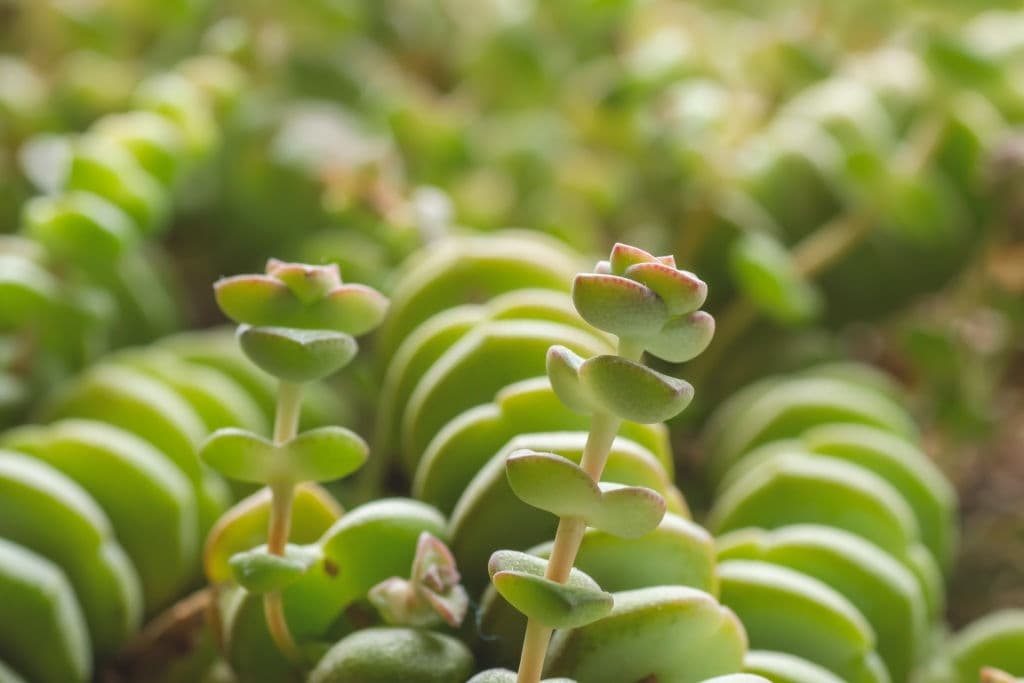
This type of jade plant is also called the String of Buttons. It best grows indoors. Identified with its triangle-shaped leaves which grow opposite towards each other around the stem.
Leaves may have a pinkish tint in the sides when put in light. It also produces flowers which are yellow in color during spring.
Related: 40+ Beautiful Flowering Succulents & Plant Identification
31. Crassula Picturata Tiger Jade
This type of Jade plant is most suitable for gardeners who are very meticulous. It is short growing and has beautiful, pagoda-like leaves. Its color is green and is heavily dotted with a shade of purple in its underside.
The leaves also come with fine hairs. What makes it unique from the other types is you can identify it if it is happy or stressed since it produces beautiful flowers when happy and turns reddish (as If angry) when stressed.
32. Crassula Pubescens Bear Paw
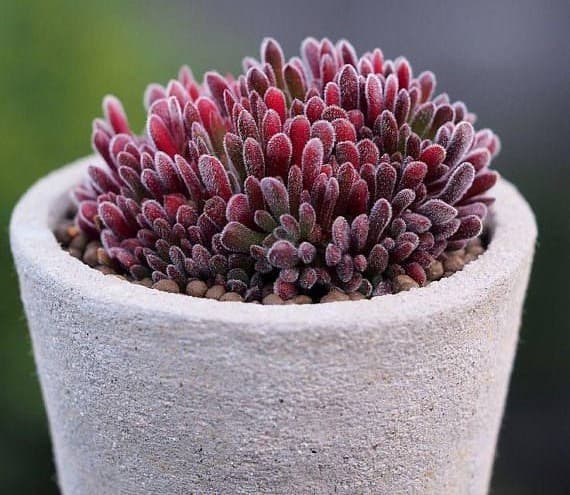
This type of Jade Plant is a low growing shrub. Its main identification is that it has leaves with green but turns to burgundy when placed under the sun. The leaves are thin but can extend up to 104 inches at the longest.
This type is also a slow-growing shrub that is used mostly as a groundcover in a garden or to anywhere its best suitable. Also, it has flowers that emerge in yellow color. Just as the other types, this too requires a bright spot but needs protection to direct sunlight.
32. Crassula pubescens ssp. rattrayi (Bear Paw Jade)
This type of Jade Plant is also called the Bear Paw Jade or Red Carpet. It has green leaves when in shade but turns bright red under.
The leaves can grow long at 4cm in length and 2cm in width. It produces a group of round white flowers that appear almost on the tip of its foliage which emerges during winter.
33. Crassula Sarmentosa Comet (Variegated Trailing Jade)
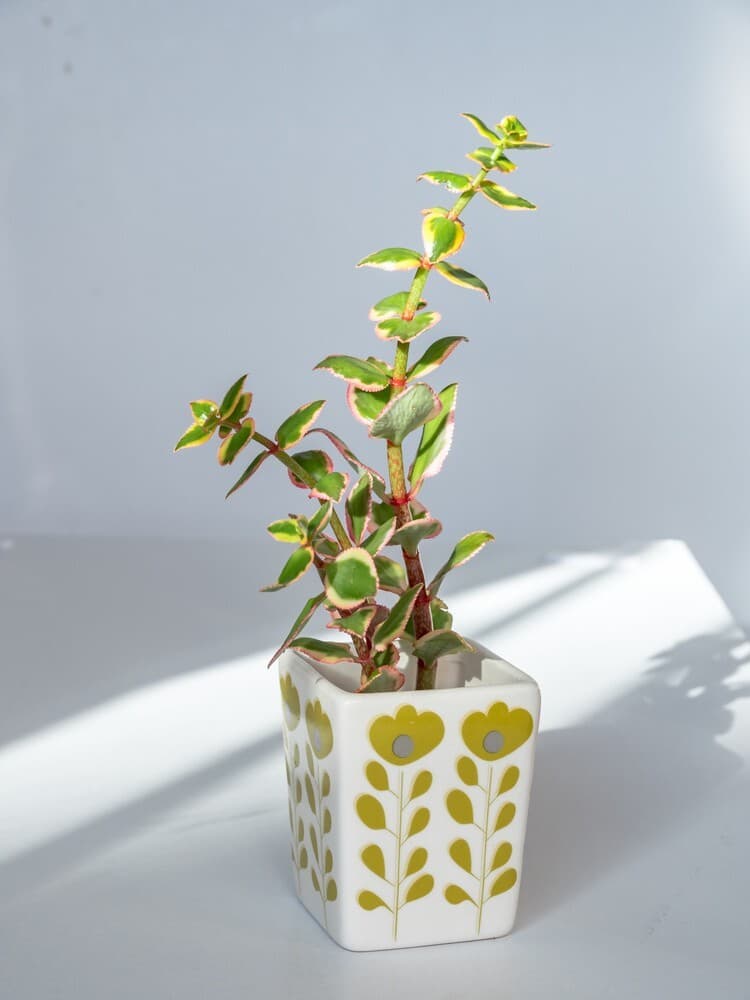
This type of Jade Plant or the Variegated Trailing Jade is known to have the most striking foliage. Its main identification is that it has red stems that can trail down. Placed under the sun, the color of the leaves changes from ink to red thin margins.
It also produces white flowers. This type of plant also has long stems so if you are planning to have it indoors, be ready to have it pruned regularly to maintain its beauty.
34. Crassula Sericea ‘Hottentotta’

This type of Jade Plant is another of the special types of Jade plants in dwarf variety. This type has fully rounded velvety leaves which surround its thin stems that grow in columns. It does not grow more than 15cm. It produces a group of tiny flowers on an extended flowerhead.
35. Crassula Silver Springtime
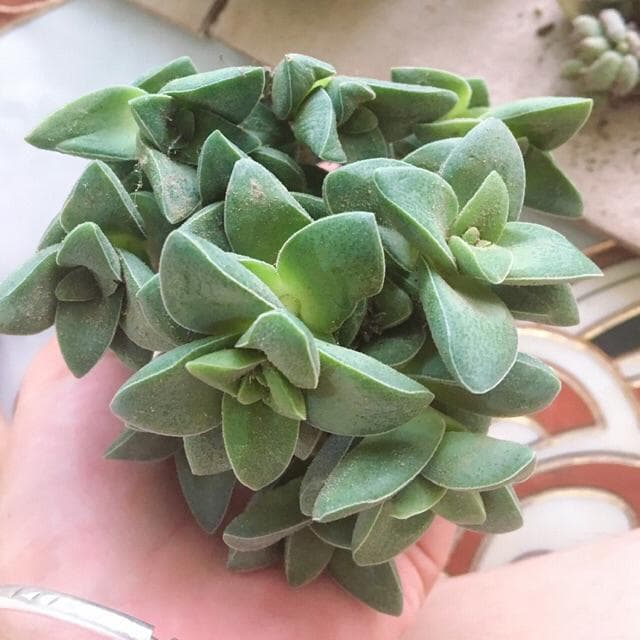
This type of Jade plant is dwarf-like in appearance and has thin stems that are loaded with a clump of silvery-green leaves. This is best indoors since it is not sun friendly.
36. Crassula Tomentosa (Wooly Crassula)

This type of Jade plant has leaves that are in rose shape. Its colors are mostly green infused with red.
The basis for its name, the Wooly Crassula is that it has fine hairs that cover its leaves. When the flower blooms, this house plant can grow up to 2ft and more.
37. Portulacaria Afra
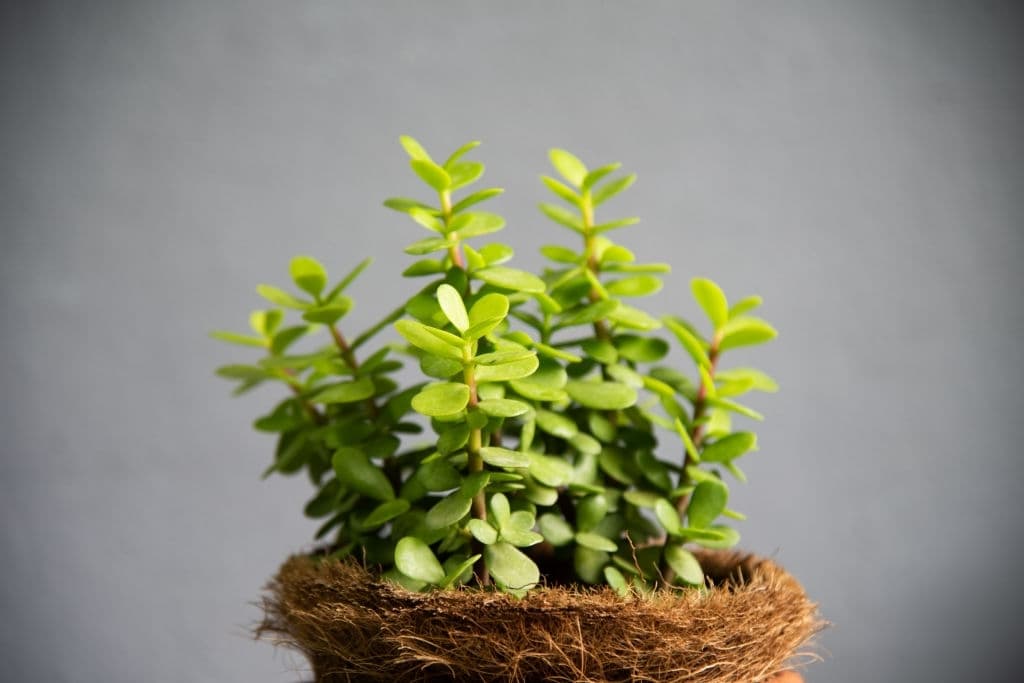
This type of Jade Plant is called the Chinese Jade Plant or Pork Bush. It is most suitable for a houseplant because of its decorative nature. It grows for about 2-meters and can be controlled with regular pruning. It can thrive in drought but shall never produce flowers, ever.
37.1. Portulacaria Afra Aurea (Yellow Rainbow Bush)
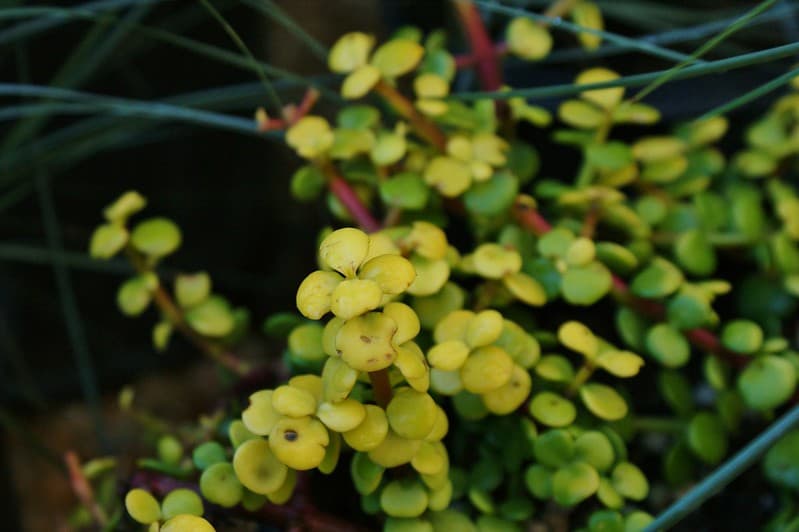
This type of Jade Plant has a nickname of Yellow Rainbow Bush of Yellow Elephant’s food. Its special feature is that its color changes as long as it is growing.
The colors depend on each time of the year and it needs water, fertilizer and can survive both in shade and in direct sunlight. The whitish pink characteristic of a jade plant is rarely produced by this jade plant.
37.2. Portulacaria Afra Cascade (Low Elephant Bush)
This type of Jade plant is also known as the Postrata—Low Elephant Bush or the Trailing Elephant Bush.
Its main identification is that it has round leaves that grow from its stems. It is also one of the types that does not produce flowers. It only grows at a height of 1 meter.
37.3. Portulacaria Afra Large Leaf
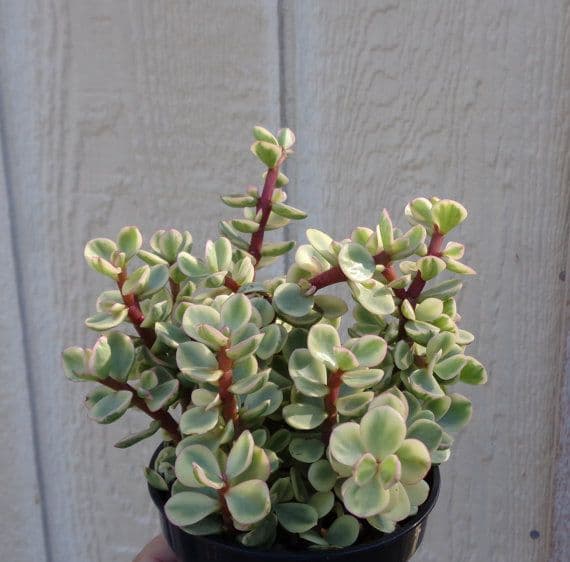
This type of Jade Plant is also known as the Green Penny Jade. It is highly identified through its fleshy leaves that grow on its dark red stems.
This plant can grow for about 2-meters in length but can be controlled through regular trimming. It is also ideal for a houseplant since it is commonly used as a decoration on balconies and patios or anywhere you want them to be seen.
37.4. Portulacaria Afra Porkbush
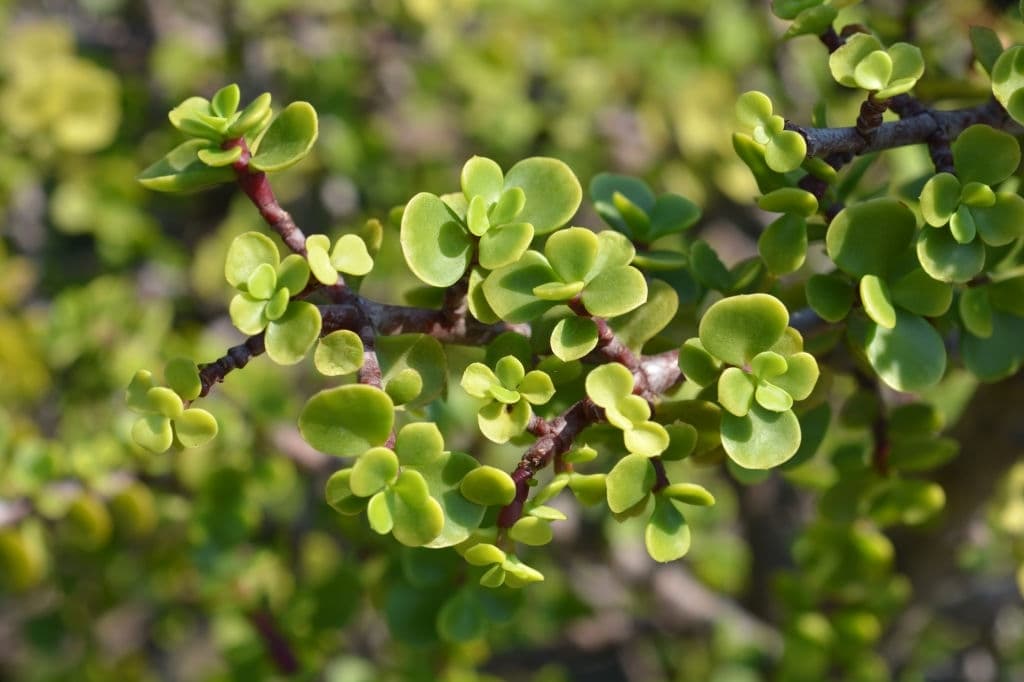
This type of Jade Plant is also referred to as Dwarf Jade. It is identified with its woody red stems and small, round and glossy green leaves.
Its special feature is that the plant grows widely after reaching its maximum height. So, with this type of Jade plant, regular trimming is highly recommended.
37.5. Portulacaria Afra Variegata
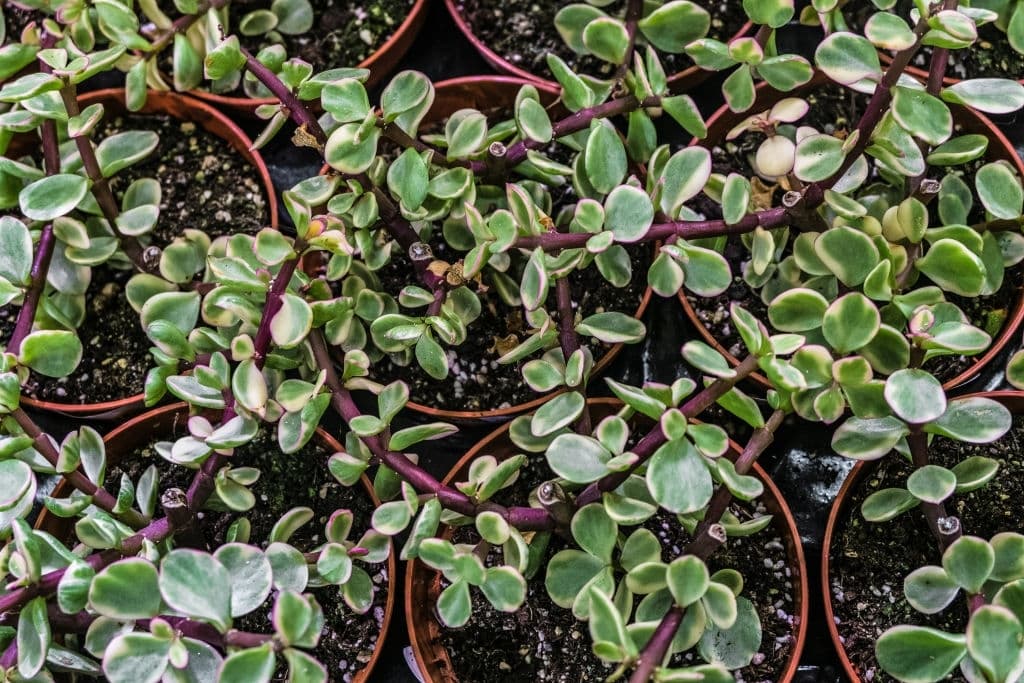
This type of Jade plant is also known as the Rainbow bush. It can be identified by the creamy leaves with light green center stripe and has a shade of magenta towards its edges. It also doesn’t produce flowers and can grow at just 1-meter in height.
38. Senecio jacobsenii (Weeping Jade)
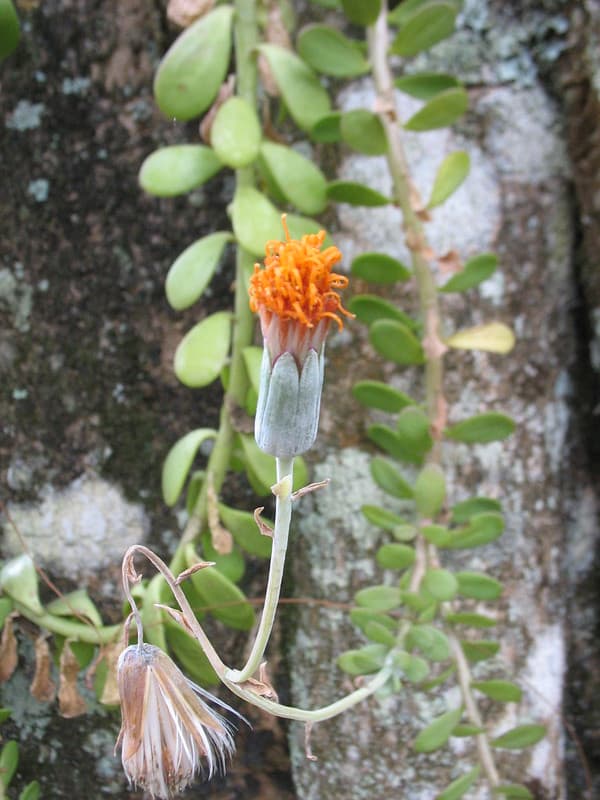
This type of Jade plant is also known as Kleonia Petraea. It is mainly identified for its hairy flowers. It has thick stems and flat, egg-shaped leaves which grows for about 3-inches.
From the word ‘trailing,’ this type keeps growing, forming a root network which can spread along the ground. For gardeners, this is the best to add to your garden since it produces bright orange flowers that pop out on your seemingly dull landscape.
39. Sinocrassula yunnanensis (Chinese Jade)
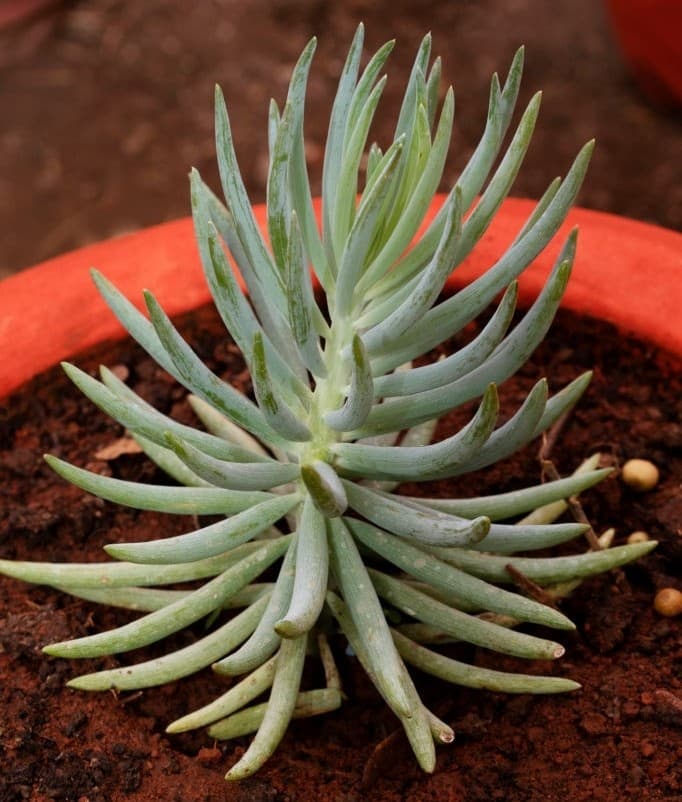
This type of Jade plant has half-round leaves. It is considered monocarpic because it dies after flowering once but is replaced by the close ones. When the flower blooms, the rosettes can grow up to 4-inches. It produces small flowers which are white in color.
Related: 15 Best Places To Buy Succulents Online
How to Care for Jade Plants
Jade plants are one of the easiest plants to look after, requiring very minimal attention. Aside from associated beliefs of prosperity and good luck in a home, it is also a prolific grower. As a gardener or a plant lover, one should look out for every plant in a home or a garden. As such, here are some ways on how to take care of your jade plants.
- Water after the soil is dry. One important care tip if you have a jade plant is to occasionally water them or water when only needed. Always make it a point that the soil, be it in the garden bed or the pot, is very dry before running it down with water.
- Keep out of direct sunlight. Keep your jade plant in shade or in bright areas because it needs direct but filtered sunlight for at least 6-10 hours a day. When putting it in direct sunlight, make sure that It is within your care and sight as too much sunlight can ruin the leaves of a jade plant.
- Prune regularly. When taking care of a jade plant, always make some time to prune. The golden trick however, is to prune when needed and not just when you like it. Pruning your jade plant is essential in keeping its shape.
- Potting. The only important thing to remember here is not to pot it in a very compact container. Jade plants need a lot of breathing space to grow in.
Related: 35+ Types Of Snake Plants With Pictures
FAQs
Which type of jade plant is lucky?
Jade plants are considered lucky plants but the most popular and bought by many is the Crassula Ovata or better known as money tree, lucky plant.
It is a widely held symbolism that this jade plant type tends to bring fortune and good luck to its owners and is very much effective when it is given to you by someone. It is so popular in this perception that its shape and overall look is even engraved in amulets, bracelets and other lucky charms.
Why is my jade plant so leggy?
The stems of the jade plant can be leggy when it lacks sunlight. Aside from looking unhealthy, it is also a sign that it is near leaf rotting. The best amendment for this is to bring out or make sure that it receives filtered sunlight everyday for at least six hours.
Are coffee grounds good for jade plants?
Coffee is believed to develop the ornamental value of jade plants. It is said that like the effect of antioxidants of coffee on people’s skins, it also aids in thickening the stems of jade plants, making them look very full and their colors very bright. Also, coffee grounds prevent the leaves from dropping.
Do jade plants give oxygen at night?
Jade plants absorb carbon dioxide and give off oxygen during the night. This makes the air quality in the room better. The air filtering quality of jade plants also make it a prime choice for indoor plants, especially in bedrooms, living rooms, and bathrooms as well as in offices.
Related: 31+ Different Types Of Aloe Plants With Pictures (Identification Guide)
Conclusion
Jade plants are not just very beautiful ornamental plants but they are also very functional at best. Aside from being the perfect indoor plants because they are fairly low maintenance, they also have the inherent capacity to filter air.
This is very beneficial in a good night’s sleep and overall well-being. Perhaps, the only thing that must be remembered about the jade plant is that it needs the right amount of sunlight and water. As for anything else, it could survive.

